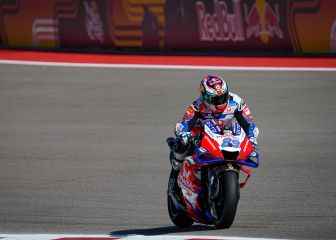The Angel Grandson of Jerez It is not the most demanding circuit on the calendar in terms of brakes, but it would be on the second row, because on the Brembo scale, the MotoGP brake distributor of choice for riders and teams, it is at level 4 out of 6 for maximum difficulty.
“Jerez is not the most demanding, but has hard braking on 1, 6 and 13. It is very distributed at the level of brake temperatures, because there is distance between powerful braking. Those brakings are demanding because you arrive very fast and you have to stop the bike a lot. How well the motorcycle brakes, you gain or lose a lot of time”, Jorge Martín confirms to AS in the presence of Andrea Bergami, a Brembo engineer who is not very clear about which rider is the best at braking, but the bike that helps the most in this regard is: “The best braker does not depend only on the rider but also on the bike he rides and in that the Ducati is the bike that helps the rider the most. They have evolved it so much that they have made it very stable, which is why the Ducati riders are the best brakers on the grid at the moment. Martín or Miller are among those who later stop”.
Martín is clear about who is the best braker for him of all time: “It is difficult to say, but I think Schwantz is the best braker in history.” And he adds on the importance of braking that “the most delicate part of braking is when entering a curve. the time. The brakes of a MotoGP bike are incredible, because of how late it allows you to brake”.
About himself, the man from Madrid considers himself a “good braker”, but with nuances: “Although it’s not my strong point, I do brake late and when overtaking I take advantage of that point. The braking of my life could be that of Misano last year, when I overtook Márquez and Quartararo, both together in the one. That point is not the strongest braking, but you have to add a couple to pass both at the same time there. Each pilot looks for a reference point to brake, be it a wall, a mark on the ground or whatever. In Dry Sack I brake a bit before the Andalusian poster. The same 15 meters, which are thousandths”.
When asked about which riders are the most demanding in terms of brakes, Bergami says: “This depends on where the rider has the brake lever. Some like to have it very close to the handlebars and that makes it easier for them to touch the handlebars , so you have to work a lot with them, because there is little room for travel. One of them is Pol Espargaró, for example. And the Suzuki riders are also very sensitive with the brakes.”
Brembo’s ventilated disc.
Vaclav Duska Jr.
The Brembo engineer takes advantage of the latest technological evolution of his factory: “The most demanding circuits for the brakes are Austria, Japan and Thailand, because they have the strongest braking and you have to keep the temperature of the brakes balanced for when the brakes arrive. braking. It’s a very hard job to do during free practice. Using the air ducts to cool the braking system. We have worked to introduce a new technology that is the ventilated disc (perforated longitudinally). There is a lot of work behind.”
But not everything is always perfect for Brembo. Two years ago at Austria 2, Maverick had to jump off the Yamaha at high speed when he ran out of brakes. Bergani gives his point of view on that: “The Maverick thing was a particular case. We had already prepared before, as we do with all the pilots. In every GP we do it. We always behave in the same way. We had checked what the situation was before the race and already in free practice we had suggested to Yamaha and Maverick to change the brake settings. We cannot impose something on the teams. We give suggestions. We say what we think and that it was better to change. Then the team decides what the configuration is. And Maverick with his team decided to keep the same setup that he was already using in free practice”. Luckily, it is something that has not happened again.
